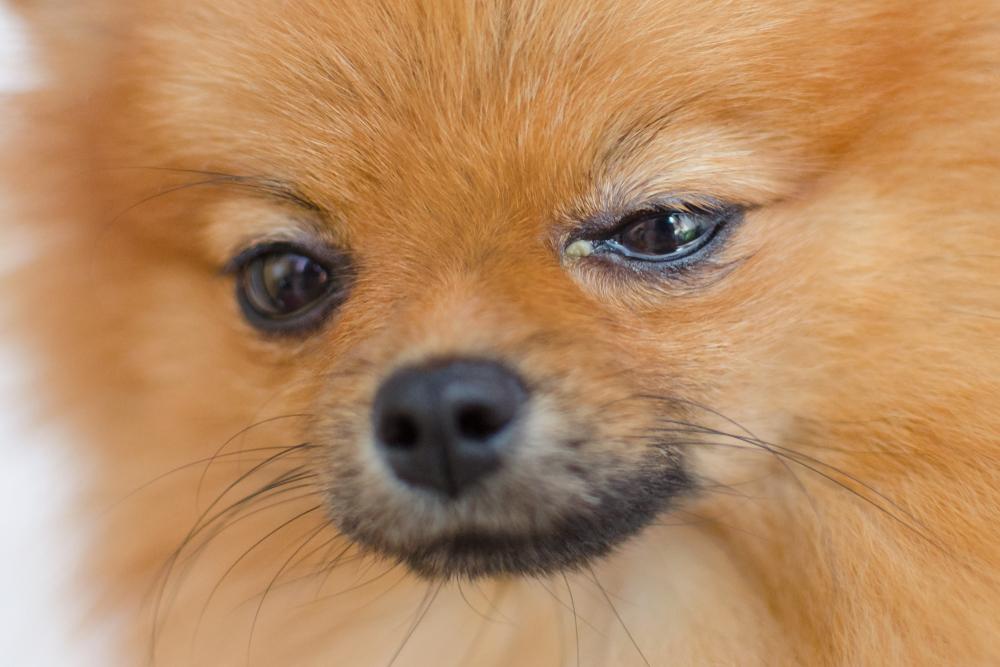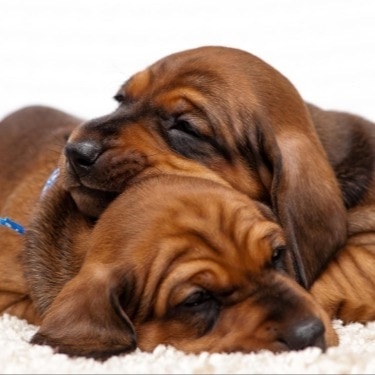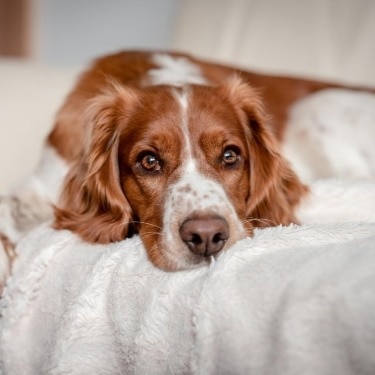

If you're a dog parent, you know how easy it is to worry when something seems off with your pup. The perfect example? Red, irritated eyes. You might see this and wonder: Does my dog have conjunctivitis? Are they getting sick? But here's the good news: although conjunctivitis in dogs can be caused by many different things, it's typically manageable with the support of your veterinarian.
Sometimes, a red eye can occur from a passing irritation, while other times, it's a bit more serious. Here's what to know about eye inflammation in dogs.
Conjunctivitis is simply the name for inflammation of the conjunctiva in the eye. The conjunctiva is a mucous membrane that lines the eyelid, eyeball and the corner of their eye, near their nose. Conjunctivitis in dogs can occur for many different reasons, but the good news is that very few of these reasons are contagious (unlike in humans and cats).
Sometimes, the eye can appear a little puffy around the edge, and in severe cases of conjunctivitis, that pink lining inside the lid can actually stick up and be visible. All of this inflammation is conjunctivitis, but it's important to note that conjunctivitis is not a diagnosis or a disease. It's simply a sign of something else going on.
Conjunctivitis may cause the eye to look red or pink, although vets do not refer to it as conjunctivitis in dogs. Signs of conjunctivitis include:
Redness where the eye should be white
Squinting or holding the eye closed
Elevation of the third eyelid (the pink or black membrane in the corner of their eye, near their nose)
Discharge from the eye that may be clear, yellow or green, depending on the condition of the eye

Dogs can get conjunctivitis from a range of things, from having a piece of dirt in the eye to a major disease. Because symptoms can look the same regardless of the cause, a visit to your vet is the best way to pinpoint the underlying cause. With a proper diagnosis, you'll have a clear treatment plan to help your pup feel better, fast.
Here are the most common causes of conjunctivitis in dogs:
Allergies
The most common cause of conjunctivitis is seasonal allergies (not that different from people!). When the mold or pollen count goes up, dogs can experience red, itchy eyes, and they may even rub their face on the floor. If your dog is experiencing allergies, you might also notice that they have a runny nose or are sneezing more frequently. In this case, medications or a special eye drop.
Foreign Objects
Sand, dirt, or parts of plants can sometimes make its way into your dog's eye, causing conjunctivitis. Pups that love to root around outside are more likely to experience this, but all dogs may end up with something in their eye from time to time, especially if it's windy.
Dry Eye
If the eye glands are not producing enough tears, the conjunctiva can become irritated, along with the rest of the eye. Some dogs with dry eye might have a goopy green discharge, which can be very uncomfortable. Certain breeds are more prone to dry eye than others, such as pugs and bulldogs.
Corneal Ulcer
Any scratch or defect in the cornea puts your pup at risk of developing a secondary bacterial infection. Brachycephalic dogs — those with smooshed faces — like shih tzus or pugs are more prone to corneal ulceration, but it can happen to any dog. If your dog has a conjunctivitis and is holding their eye closed, it could be an ulcer causing the conjunctivitis. Your vet may apply a colored drop to your dog's eye to test for damage to the cornea and prescribe eye drops as needed.
Eyelashes
Some breeds (like shih tzus) are prone to having eyelashes grow in the wrong direction and irritate the conjunctiva. These can be surgically removed if they are causing irritation.
In dogs, conjunctivitis is most often secondary to something else, so it's important to call your vet with any eye concerns and have your dog examined. Eye irritation could be a minor allergy, or it could be a sign of something more serious, so getting it checked out as soon as possible is always a good idea. Your vet will perform a physical exam, as well as examine the eye up close with an ophthalmoscope. They may also:
Apply a colored dye to look for corneal ulcers
Flush the eye with saline to rinse out foreign objects
Perform a Schirmer tear test to rule out dry eye
Because your dog's breed and age play a part in their risk factor for certain conditions, your vet may perform other tests, as well. The good news is, most causes of conjunctivitis in dogs are rather straightforward to diagnose, and you'll likely leave your vet with a clear treatment plan.
Treating conjunctivitis depends on the underlying cause. In some cases, the cause of the conjunctivitis is very serious, and is a major emergency. In other cases, it's a mild inconvenience. Allergic conjunctivitis can be treated with medications or medicated eye drops. Corneal ulcers, on the other hand, can be a major emergency. Treatment of corneal ulcers often involves an aggressive regimen of eye drops. Another potential conjunctiva-related emergency is foreign objects, such as foxtail awns. These thornlike pieces of the plant can be very painful, and must be removed by a vet, often under anesthesia.
The best way to determine the right course of action is to get an accurate diagnosis from your vet.
Maintaining your dog's eye health is a key part of keeping them healthy and happy. The best way to do this is by monitoring your dog's eyes for any redness, discharge or squinting. If you notice any of these symptoms, get them checked out by your vet soon, since the causes of conjunctivitis can potentially be serious. Other factors that can help minimize the risk of conjunctivitis include:
Avoiding common allergens like secondhand smoke or strong chemicals
Feeding a complete and balanced food
Scheduling regular vet visits
If your dog has been diagnosed with an eye disease and is on medication, it's important to give the medication regularly as directed by your vet. It can be challenging to administer eye drops to dogs, so if you're struggling, speak up! Your vet may be able to offer you some creative ideas to ensure your dog's eyes get their treatment consistently.
Is conjunctivitis in dogs contagious to other dogs or humans?
Conjunctivitis in dogs is not typically contagious to other dogs or humans. However, if you have other dogs with similar symptoms, it's possible that there may be a common allergen affecting them.
Can dogs get conjunctivitis from humans?
Conjunctivitis is not the same thing in dogs as it is in humans. It is extremely rare for dogs to catch conjunctivitis from humans.
Can conjunctivitis go away by itself?
The inflammation of the conjunctiva can have many causes, some of which can be serious. It's best to consult your vet for a proper diagnosis and treatment.
How long does conjunctivitis in dogs last?
Dogs typically do not get infectious conjunctivitis like people do. Conjunctivitis, the inflammation of the lining of the conjunctiva, can have many causes, which affect how long the condition lasts.





















